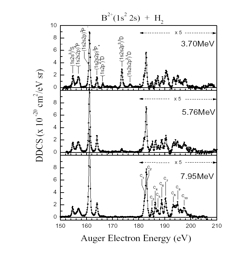Zero-degree Auger projectile electron spectroscopy of B2+ in 3-8 MeV
collisions with H2
T.J.M. Zouros1,2, E.P. Benis2 and Pat Richard3
1) Department of Physics, University of Crete, Heraklion, Crete, Greece
2) Inst. of Electronic Structure and Laser, FORTH, P.O. Box 1527, 71110 Heraklion, Crete, Greece
3) Dept. of Physics, J.R. Macdonald Lab., Kansas State University, Manhattan, KS 66506-2604
Recently, we have reported on the investigation
of electron production mechanisms in H-like
and He-like [1, 2] boron ions in collisions with H2
gas targets. The projectile electron spectra were
found to result predominantly from the Auger decay
of doubly or triply excited [3] states produced
by direct capture or resonant elastic/inelastic
scattering of quasi-free target electrons off the
ions. Here, we follow-up these investigations with
a report on electron production in 4-8 MeV collisions
of Li-like B2+(1s22s) with H2 targets.
The high resolution spectra for all the boron
charge states were recorded at zero-degrees with
respect to the ion beam with a mean instrumental
energy resolution of 0.2% and an absolute experimental
uncertainty in the Auger line energy
(projectile rest frame) of 0.6-1.1 eV. The three
electron spectra for B2+ collisions with H2 are
shown in Fig. 1. The Be-like
1s2s2p2 3,1D lines
are known to be produced by resonant elastic
scattering off the B2+ ion of the quasi-free H2
electrons. These lines go through a maximum
at the ion collision energy of 3.8 MeV. The Li-
like (1s2s)2p 2P- and
1s2p2 2D lines are produced
by direct excitation. The energies of higher-
lying KLn lines (c1-c10) have been compared to
Hartree-Fock calculations using the Cowan code.
Our analysis shows most of these lines can be assigned
to Li-like 1s2lnl" states with n = 3 - 4
Auger decaying to the B3+(1s2) ground state.
The proposed intermediate states, the Auger
electron energies resulting from their decay to the
ground state, and the most probable production
mechanisms are discussed.

Figure 1: Absolute electron double differential cross sections (DDCS)
for 3.70, 5.76 and 7.95 MeV collisions of B2+(1s22s) with H2. The production of
the 2S, 4P, 2P-, 2P+ and 2D Li-like doubly excited states is most prominent.
The Be-like doubly excited states
(1s2s2p2)3D and
(1s2s2p2)1D are also observed.
Higher-lying KLn lines (c1-c10) are scaled for improved presentation as indicated.
References:
[1] T. J. M. Zouros, E. P. Benis and T. W. Gorczyca, 68, 010701(R) (2003).
[2] E. P. Benis, T.J.M. Zouros, T. W. Gorczyca, A. D. González and P. Richard,
Phys. Rev. A 69, 052718 (2004).
[3] E. P. Benis, T. J. M. Zouros, T. W. Gorczyca, M. Zamkov, and P. Richard,
J. Phys. B 36, L341-L348 (2003).
This work was supported by the
Chemical Sciences, Geosciences and Biosciences Division,
Office of Basic Energy Sciences,
Office of Science,
U.S. Department of Energy.
Submitted to ICPEAC, July 2005 in Rosario, Argentina.
This abstract is also available in
Adobe Acrobat format.
